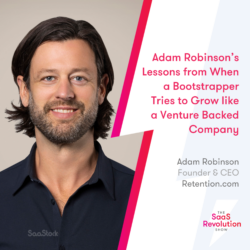User-centric design isn’t just a buzzword—it’s the cornerstone of a product that truly engages users at every stage of their journey. While onboarding is often highlighted as a critical phase for capturing initial interest, the reality is that a user-centric approach must be woven into every interaction—from the first click to daily use and beyond. A design that puts the user first not only improves the overall experience but also drives higher engagement, retention, and satisfaction.
Why User-Centric Design Matters in SaaS
Beyond Onboarding: A Continuous Journey
Many SaaS app development providers focus heavily on user onboarding, rightly so—first impressions count, and an intuitive, welcoming onboarding process can set the stage for long-term success. However, the user experience shouldn’t stop once the initial hurdles are overcome. A user-centric design must be an ongoing commitment that adapts and evolves alongside your users’ needs.
- Initial Impressions:
Onboarding is where users first interact with your product, and a well-designed onboarding process can reduce churn and ensure users quickly see value. But even the best onboarding can lose its impact if the core product doesn’t continue to meet users’ expectations. - Daily Use and Engagement:
Whether it’s daily task management, project collaboration, or data analysis, a SaaS product must be designed to make routine interactions as intuitive and efficient as possible. This is where user-centric design really shines—by reducing friction, streamlining workflows, and continuously adapting to user feedback. - Long-Term Relationships:
Engagement is not a one-time achievement; it’s built over time. A user-centric approach that values clarity, usability, and aesthetic consistency fosters trust and encourages users to remain active, providing the groundwork for long-term loyalty.
The Human Element in Technology
At its core, user-centric design is about empathy. It’s about understanding the user’s challenges, preferences, and behaviors—and then designing solutions that feel natural and supportive. When users feel that a product is built with their needs in mind, they are more likely to develop a positive emotional connection with the platform. This connection not only improves satisfaction but also makes users more likely to advocate for the product and contribute to its growth.
Core Principles of User-Centric Design in SaaS
1. Empathy-Driven Development
Understanding your users is the first step in creating a user-centric product. This means engaging with users through surveys, interviews, and usability tests to gather insights into their pain points and expectations. By putting yourself in your users’ shoes, you can design features and interfaces that resonate with their needs.
Best Practice:
- Conduct regular usability testing sessions. Observe how users interact with your product and use this feedback to iterate on your design.
2. Simplicity and Clarity
Simplicity isn’t about stripping away features; it’s about presenting information in a clear, digestible way. A clutter-free interface allows users to focus on what’s important, reducing cognitive overload and making it easier to navigate complex processes. No matter if it’s an ecommerce checkout or EV charging business software migration – clear, simple layouts make tough tasks feel manageable.
Example:
A project management tool that uses clear, visual progress indicators and straightforward navigation menus ensures that users can manage tasks without feeling overwhelmed.
3. Consistency Across Touchpoints
Consistency in design builds familiarity and trust. When users encounter a consistent look, feel, and behavior throughout your SaaS product, they’re more likely to trust it and use it regularly.
Tip:
- Develop a comprehensive style guide that includes typography, color schemes, and component behaviors. This ensures that every update or new feature aligns with your overall design vision.
4. Accessibility for All Users
A truly user-centric design is accessible to everyone, including users with disabilities. By adhering to accessibility standards, you not only widen your user base but also enhance the overall usability of your product.
Best Practice:
- Incorporate accessibility features like keyboard navigation, screen reader compatibility, and adjustable text sizes. Regularly audit your product for accessibility compliance.
5. Responsive and Adaptive Design
In today’s multi-device world, your SaaS product must perform flawlessly on desktops, tablets, and smartphones. Responsive design ensures that your product adapts to different screen sizes without sacrificing functionality or aesthetics.
Example:
A SaaS dashboard that reflows its content seamlessly across devices allows users to access vital information on the go, whether they’re at their desk or on a mobile device.
Enhancing Engagement Through User-Centric Design
6. Personalized Experiences
Personalization is more than just inserting a user’s name into an email—it’s about creating experiences that feel tailored to the individual. Using data analytics, you can offer personalized dashboards, recommendations, and workflows that align with each user’s behavior and preferences.
Example:
A CRM tool that customizes its dashboard based on the user’s most frequent tasks can improve productivity and user satisfaction, making it easier for them to find what they need quickly. Integrating makerspace software can further enhance personalization by allowing users to tailor their creative workflows and tool access based on their unique project needs.
Example 2:
A SaaS company implementing a referral program can boost engagement by making the experience seamless and rewarding. For instance, using ReferralCandy, businesses can offer personalized referral links and incentives based on user behavior. If a customer frequently engages with a specific product or service, they might receive tailored rewards that align with their interests, increasing the likelihood of participation.
7. Interactive and Intuitive Interfaces
Interactivity plays a key role in engaging users. Interactive elements such as drag-and-drop interfaces, real-time feedback, and smooth transitions make a product feel dynamic and responsive. Intuitive design reduces the learning curve and encourages users to explore more of your product’s features.
Best Practice:
- Use micro-interactions (small, subtle animations) to provide feedback for user actions. These interactions can make the experience more engaging and delightful.
8. Continuous Improvement Based on User Feedback
User-centric design is an iterative process. Continuously gathering and analyzing user feedback helps you understand what’s working and where improvements are needed. Regular updates that address user concerns not only enhance the product but also signal to users that their opinions are valued.
Tip:
- Implement in-app feedback tools that allow users to share their thoughts in real time. Regularly review this feedback and prioritize updates that will have the greatest impact on user satisfaction.
9. Gamification to Boost Engagement
Gamification introduces elements of play into the user experience, motivating users through rewards, challenges, and progress tracking. When done thoughtfully, gamification can drive engagement by making routine tasks more enjoyable and encouraging users to explore features they might otherwise overlook.
Real-World Example:
A SaaS learning platform might incorporate gamification by awarding badges (e.g., using a badge creator online) for completing modules or reaching milestones. This not only motivates users to engage with the content but also provides a visual representation of their progress, fostering a sense of achievement.
10. Robust Onboarding and Continuous Education
Onboarding is a critical phase, but learning shouldn’t stop after the initial sign-up. A robust onboarding process that gradually introduces users to advanced features, along with continuous education through tutorials, webinars, and in-app tips, ensures that users remain engaged long-term.
Best Practice:
- Develop a multi-step onboarding process that guides users through key features with interactive walkthroughs. Follow up with regular updates and educational content that helps users get the most out of your product.
Real-World Examples of User-Centric SaaS Design
Example 1: Slack
Slack’s success is largely attributed to its user-centric design. From an intuitive interface that requires minimal training to its personalized onboarding experience, Slack makes it easy for users to adapt and integrate the tool into their daily workflows. The platform continuously evolves by listening to user feedback and implementing improvements, ensuring high engagement and retention rates.
Example 2: Asana
Asana’s project management platform is another example of user-centric design. With a clean, organized interface, Asana provides a seamless experience across devices. It offers personalized dashboards that adjust to the user’s role and project needs, reducing friction and enhancing productivity. Regular updates and interactive features, such as task progress tracking and visual project timelines, keep users engaged and informed.
Example 3: HubSpot
HubSpot, a leader in inbound marketing and sales software, integrates user-centric design by offering a customizable dashboard and an array of educational resources. Their onboarding process includes interactive tutorials and continuous updates that help users navigate new features and functionalities. HubSpot’s commitment to personalization and ease of use has resulted in high user satisfaction and robust long-term engagement.
The Psychological Impact of User-Centric Design
Understanding the psychology behind user-centric design can further illuminate its benefits. When a product is designed with the user in mind, it reduces cognitive load, making interactions feel effortless and intuitive. This ease of use minimizes frustration, leading to a more positive emotional experience.
Reduced Cognitive Load
A well-designed interface simplifies complex tasks, which lowers the cognitive effort required from the user. This means that instead of feeling overwhelmed by multiple options or complicated processes, users can focus on their goals without distraction.
Increased Sense of Ownership
Personalization and continuous improvement create a feeling of ownership. When users see that a product adapts to their needs and values their input, they are more likely to feel invested in its success. This emotional investment drives loyalty and encourages users to become advocates for the product.
Enhanced Trust and Reliability
Consistency in design and functionality builds trust. When users know what to expect every time they interact with your SaaS product, it establishes reliability. This trust is crucial not only for user retention but also for encouraging users to explore advanced features and adopt the product as an integral tool in their workflow.
Final Thoughts
User-centric design is not just a feature—it’s a philosophy that should permeate every aspect of your SaaS product. From the first interaction during onboarding to daily engagement and ongoing education, designing with the user in mind is essential for building long-term relationships and driving continuous engagement.
By focusing on empathy, simplicity, consistency, and personalization, you can create a product that not only meets user needs but also delights and inspires them. The integration of interactive elements, continuous improvement based on feedback, and even gamification can elevate the user experience, making your SaaS product a trusted tool that users rely on every day.
In a world where competition is fierce and customer expectations are constantly evolving, investing in user-centric design is not optional—it’s a necessity. The benefits go beyond usability; they foster emotional connections, enhance trust, and ultimately drive the success of your SaaS business.





